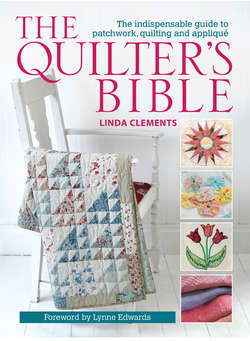Читать книгу The Quilter's Bible - Linda - Страница 70
На сайте Литреса книга снята с продажи.
ОглавлениеEnglish Paper Piecing
This type of patchwork, also called English patchwork, is often one of the first techniques that beginners learn. The patchwork uses templates, usually made of thick paper, thin card or freezer paper, which fabric pieces are wrapped around and tacked (basted) to (or pressed in the case of freezer paper). The fabric patches are then hand sewn together, usually with whip stitch and the papers removed.
These master templates are used for cutting papers for English patchwork. These are also useful for ‘fussy cutting’, where you want to feature a specific motif.
This technique may be slow but one of its big advantages is that it is portable. It also allows complex designs to be built up and some lovely effects achieved. You can buy templates for English paper piecing or make your own (see Making a Simple Template). Templates are available in various shapes and sizes and in different materials. ‘Master’ shapes made from acrylic or metal are very durable. Accurate shapes can also be created using isometric paper, which is composed of 60 degree triangles (see Using Isometric Paper).
Designs created with English paper piecing can be used as appliqué attached to a plain or pieced background. This wall hanging was created this way, using elongated octagons. The shapes were edged with narrow ricrac braid but a machine satin stitch or hand blanket stitch could be used instead. The octagon shape was used again for the hand quilting.
Creating Patterns
The most common and useful shapes are triangles, diamonds and hexagons, which allow you to create many patterns. These shapes can be combined with squares and rectangles to produce many innovative patchwork designs.
(left to right) Grandmother’s Flower Garden; Field of Diamonds; Six-point Star; Brick Pile; Ocean Wave; Inner City
